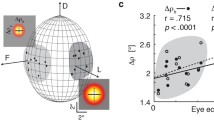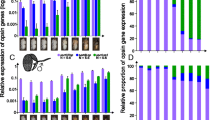Summary
-
1.
The limits of the visual fields and the binocular region of the compound eyes of the worker honey bee were determined by observing the ‘pseudopupil’. The visual field data (Table 1) are valid for a defined, reproducible head-position (Fig. 2). This also means that a stereotaxic system for the bee's compound eyes is now available. The relevant angles are defined in Figs. 1, 3, 4, 5.
-
2.
The extent of the binocular domain in the horizontal plane which lies 490 μm above the bases of the antennae (Figs. 2A, 5) is 29 °. The dorsal binocular field in the vertical plane which is perpendicular to the longitudinal body-axis extends over 42 °; the corresponding value for the ventral binocular field is 31 ° (Figs. 5, 6).
-
3.
The lines of view of the medial peripheral ommatidia of the compound eyes intersect 5.6 mm in front of the head in the horizontal plane. In the vertical plane, we obtained a corresponding value of 2.8 mm dorsally and 4.7 mm ventrally. Each of these points of intersection marks the start of the binocular space in the respective plane (Figs. 5, 6).
-
4.
The visual field is almost a complete sphere (Figs. 6, 7). The extent of the caudally-situated dead space is not due to the shape of the thorax and abdomen; rather, the lines of view of the peripheral lateral ommatidia skirt the outlines of the thorax.
-
5.
The ‘monocular-binocular-boundary’ in the facetal array of the compound eye was established. This boundary separates the ommatidia whose lines of sight are directed towards the binocular domain from those ommatidia which look solely into the visual field of the respective eye (= monocular visual field). We further determined the lines of sight and the x-, y- and z-coordinate values of certain ommatidia which lie on this monocular-binocular-boundary (Table 1). 31% of all ommatidia of the bee belong to the binocular region (Fig. 8).
-
6.
Medial peripheral ommatidia of one eye and corresponding ommatidia on the monocular-binocular-boundary of the other eye, i.e., ommatidia which look at the same point in space, usually are located ondifferent z-rows (Fig. 9, Table 1).
-
7.
The ommatidial array of the compound eye was examined. A regular hexagonal lattice occurs at the centre of the eye; irregularities are present in the dorsal and ventral regions. An x-y-z coordinate system can be used to quantitatively describe the position of particular facets in the ommatidial array (Fig. 8).
-
8.
Both the number of x-, y- and z-rows as well as the total number of ommatidia vary from animal to animal and — to a lesser extent — between the right and left eyes of any one bee. The average number of ommatidia per eye is 5,432.
-
9.
An estimate was made of the visual fields of the 3 ocelli of the bee (Fig. 10).
Similar content being viewed by others
References
Baumgärtner H (1928) Der Formensinn und die Sehschärfe der Bienen. Z Vergl Physiol 7:56–143
Beersma DGM, Stavenga DG, Kuiper JW (1977) Retinal lattice, visual field and binocularities in flies. J Comp Physiol 119:207–220
Braitenberg V (1967) Patterns of projection in the visual system of the fly. 1. Retina-lamina projections. Exp Brain Res 3:271–298
Burkhardt D, Darnhofer-Demar B, Fischer K (1973) Zum binokularen Entfernungssehen der Insekten. 1. Die Struktur des Sehraums von Synsekten. J Comp Physiol 87:165–188
Demoll R, Scheuring L (1912) Die Bedeutung der Ocellen der Insekten. Zool Jahrb Abt Allg Zool Physiol Tiere 31:519–628
Frantsevich LI, Pichka VE (1976) The size of binocular zone of the visual field in insects (in Russian). Zh Evol Biokhim Fiziol 5:461–465
Gemperlein R (1969) Grundlagen zur genauen Beschreibung von Komplexaugen. Z Vergl Physiol 65:428–444
Honegger H-W (1980) Receptive fields of sustained medulla neurons in crickets. J Comp Physiol 136:191–201
Horridge GA (1978) The separation of visual axes in apposition compound eyes. Philos Trans R Soc Lond [Biol] 285:1–59
Kaiser W, Seidl R, Vollmar J (1977) The participation of all three colour receptors in the phototactic behaviour of fixed walking honeybees. J Comp Physiol 122:27–44
Seidl R (1980) Die Sehfelder und Ommatidien-Divergenzwinkel der drei Kasten der Honigbiene. Verh Dtsch Zool Ges 1980:367
Seidl R, Kaiser W (1979) Das Seh- und Binokularfeld der Honigbiene,Apis mellifica carnica. Verh Dtsch Zool Ges 1979:305
Seitz W (1968) Der Strahlengang im Appositionsauge vonCalliphora erythrocephala (Meig.). Z Vergl Physiol 59:205–231
Stavenga DG (1979) Pseudopupils of compound eyes. In: Autrum H (ed) Handbook of sensory physiology, vol VII/6A. Springer, Berlin Heidelberg New York, pp 357–439
Wehner R (1972) Pattern modulation and pattern detection in the visual system of Hymenoptera. In: Wehner R (ed) Information processing in the visual systems of arthropods. Springer, Berlin Heidelberg New York, pp 183–194
Wehner R, Flatt I (1977) Visual fixation in freely flying bees. Z Naturforsch 32c:469–471
Wehner R, Bernard G, Geiger E (1975) Twisted and non-twisted rhabdoms and their significance for polarisation detection in the bee. J Comp Physiol 104:225–245
Author information
Authors and Affiliations
Additional information
We wish to thank the Deutsche Forschungsgemeinschaft (DFG) for support under the programme ‘Sonderforschungsbereich 45 (Vergleichende Neurobiologie des Verhaltens)’. We would like to sincerely thank Mrs. Jana Steiner-Kaiser for critically reading the manuscript and for the translation. We are indebted to Mr. T. Zaschka who built the perimeter apparatus and to Miss P. Hosumbek for help in preparing the drawings. Prof. R. DeVoe and an anonymous referee suggested valuable improvements to the manuscript.
Rights and permissions
About this article
Cite this article
Seidl, R., Kaiser, W. Visual field size, binocular domain and the ommatidial array of the compound eyes in worker honey bees. J. Comp. Physiol. 143, 17–26 (1981). https://doi.org/10.1007/BF00606065
Accepted:
Issue Date:
DOI: https://doi.org/10.1007/BF00606065




